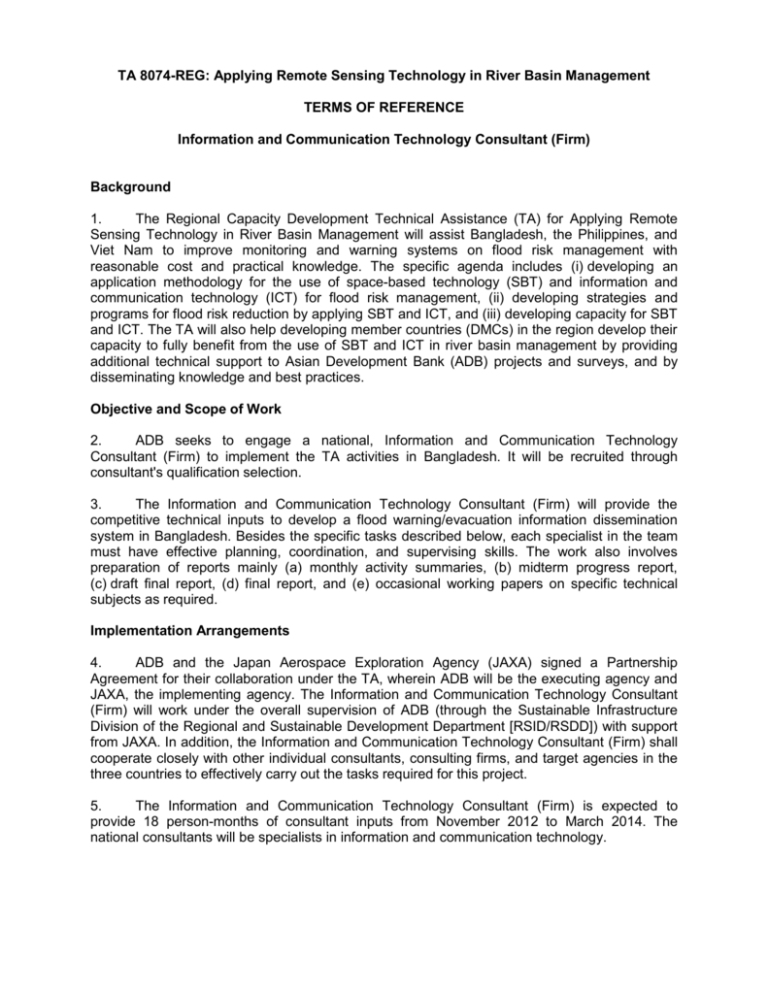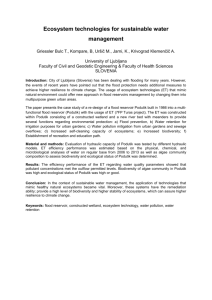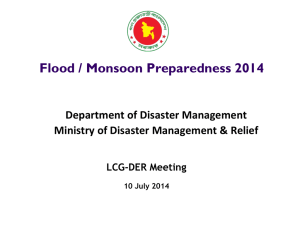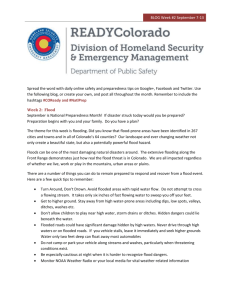Regional Technical Assistance 6470 on Managing Water in Asia*s
advertisement

TA 8074-REG: Applying Remote Sensing Technology in River Basin Management TERMS OF REFERENCE Information and Communication Technology Consultant (Firm) Background 1. The Regional Capacity Development Technical Assistance (TA) for Applying Remote Sensing Technology in River Basin Management will assist Bangladesh, the Philippines, and Viet Nam to improve monitoring and warning systems on flood risk management with reasonable cost and practical knowledge. The specific agenda includes (i) developing an application methodology for the use of space-based technology (SBT) and information and communication technology (ICT) for flood risk management, (ii) developing strategies and programs for flood risk reduction by applying SBT and ICT, and (iii) developing capacity for SBT and ICT. The TA will also help developing member countries (DMCs) in the region develop their capacity to fully benefit from the use of SBT and ICT in river basin management by providing additional technical support to Asian Development Bank (ADB) projects and surveys, and by disseminating knowledge and best practices. Objective and Scope of Work 2. ADB seeks to engage a national, Information and Communication Technology Consultant (Firm) to implement the TA activities in Bangladesh. It will be recruited through consultant's qualification selection. 3. The Information and Communication Technology Consultant (Firm) will provide the competitive technical inputs to develop a flood warning/evacuation information dissemination system in Bangladesh. Besides the specific tasks described below, each specialist in the team must have effective planning, coordination, and supervising skills. The work also involves preparation of reports mainly (a) monthly activity summaries, (b) midterm progress report, (c) draft final report, (d) final report, and (e) occasional working papers on specific technical subjects as required. Implementation Arrangements 4. ADB and the Japan Aerospace Exploration Agency (JAXA) signed a Partnership Agreement for their collaboration under the TA, wherein ADB will be the executing agency and JAXA, the implementing agency. The Information and Communication Technology Consultant (Firm) will work under the overall supervision of ADB (through the Sustainable Infrastructure Division of the Regional and Sustainable Development Department [RSID/RSDD]) with support from JAXA. In addition, the Information and Communication Technology Consultant (Firm) shall cooperate closely with other individual consultants, consulting firms, and target agencies in the three countries to effectively carry out the tasks required for this project. 5. The Information and Communication Technology Consultant (Firm) is expected to provide 18 person-months of consultant inputs from November 2012 to March 2014. The national consultants will be specialists in information and communication technology. 2 Outline Terms of Reference for Consultants 6. The summary of consulting services required, including qualifications and tasks to be performed, is as follows: (a) ICT Specialist 1 / Team Leader – (10 person-months) The ICT Specialist 1 will have a bachelor’s degree or higher in the field of ICT, or a comparable discipline, and more than 5 years of experience in the field of computer and information system using short message services (SMSs) or cell broadcasting system in Bangladesh. The specialist will develop a location-based local flood warning/evacuation information dissemination system using SMS or cell broadcasting messages which can be sent and delivered to cell phones present in any specific area which could be as small as the coverage of a single cell. The specialist will also provide records of cellular phone use (voice call/SMS) without any personal data (anonymous) for the estimation of population of a selected area. The specialist will: (i) (ii) (iii) (iv) (v) (b) Review existing regulations and systems on SMS and cell broadcasting systems in Bangladesh; Develop software architecture, program, and test documents, and quality control documents to achieve system requirement; Develop a location-based local flood warning/evacuation information dissemination system to send SMS or cell broadcasting messages to citizens present in any specific area with the size of a few unions and not greater than a single district, in a selected area in Bangladesh; Provide SMSs or cell broadcasting messages through the system developed in (iii) during the TA period and support emergency drill (evacuation training) activity using the developed system conducted during the TA; and Provide selected fields of records of cellular phone activities (call/SMS) without personal data (anonymous) for the estimation of population of a selected area in Bangladesh. ICT Specialist 2 – (8 person-months) The ICT Specialist 2 will have a bachelor’s degree or higher in the field of ICT, or a comparable discipline, and more than 3 years of experience in the field of computer and information system using SMSs or cell broadcasting systems in Bangladesh. The specialist will support ICT Specialist 1 to develop location-based local flood warning/evacuation information dissemination system which can send SMS or cell broadcasting messages to cell phones present in a selected area in Bangladesh. The specialist will: (i) (ii) Support ICT Specialist 1 to develop software architecture, program, and test documents, and quality control documents for location-based local flood warning/evacuation information dissemination system which can send SMS or cell broadcasting messages to cell phones present in any specific area; Support ICT Specialist 1 to develop location-based local flood warning/evacuation information dissemination system which can send SMS or cell broadcasting messages to cell phones present in any specific area in a selected area in Bangladesh. 3 Work and Output/Reporting Requirements 7. The Information and Communication Technology Consultant (Firm) will be responsible for all reporting and ensuring the timely submission of the deliverables listed below: (i) Implementation materials by 4 weeks after the mobilization of contract and reports (inception by 20 December 2012, midterm by 1 May 2013, draft final by 1 March 2014, and final by 31 March 2014). (ii) Software architecture, program, and test documents, and quality control documents for location-based local flood warning/evacuation information dissemination system which can send SMS or cell broadcasting messages to cell phones present in a selected area in Bangladesh by 1 March 2014. (iii) location-based local flood warning/evacuation information dissemination system using SMS which can send SMS or cell broadcasting messages to cell phones present in a selected area in Bangladesh by 1 March 2014 (preliminary version by 30 April 2013, updated version by 30 September 2013). 4 Reference; Key knowledge applied to TA 1. Space-based technology (SBT) (a) Calibration and validation of GSMaP with ground observation data Ground based rainfall observation network is widely deployed around the world for weather forecasting, water related disaster management and integrated water resource management but they are mainly located in developed countries and unevenly distributed. In addition, it may sometimes be difficult to get rainfall data for international river basin in timely fashion. Therefore, because space based observation provide uniform and high quality rainfall information regularly all over the world, the space based rainfall observation becomes powerful tool. JAXA offers hourly Global Rainfall Map in Near-Real-Time (GSMaP_NRT), available four hours after observation with 0.1 degree grid in global area (60N - 60S), using the JAXA Global Rainfall Watch System. The system is based on the combined Mircowave-Infrared algorithm using TRMM TMI, Aqua AMSR-E, DMSP SSM/I and SSMIS, and Geostationary meteorological satellites’ infrared data developed by the GSMaP project. The GSMaP project was promoted for the study "Production of a high-precision, high-resolution global precipitation map using satellite data" sponsored by Core Research for Evolutional Science and Technology (CREST) of the Japan Science and Technology Agency (JST) during 2002-2007 and this project is promoted by the JAXA Precipitation Measuring Mission (PMM) Science Team in Earth observation research center (EORC) since 2007. The main feature of the GSMaP algorithm is utilization of various attributes derived from TRMM PR (Tropical Rainfall Measurement Mission Precipitation Radar) developed by JAXA and NICT that is the first and only spaceborne precipitation radar. GSMaP_NRT rainfall products differ from GSMaP standard products in terms of input datasets, although the basic algorithms are the same for both. International Precipitation Working Group (IPWG) co-sponsored by the Coordination Group for Meteorological Satellites (CGMS) and WMO was established to promote standard operational procedures and common software for deriving precipitation measurements from satellites including GSMaP. The IPWG members have studied intercomparison of precipitation derived from numerical weather models, satellites, and ground radar and/or rain gauge networks in five active sites (North America, South America, Australia, Western Europe and Japan) and show the good synergy results. For GSMaP calibration and validation, JAXA with Japanese scientists play a main role to verify high resolution satellite based rainfall estimates around Japan using rain gauges and gauge calibrated ground radar dataset, upon their experiences in developments of GSMaP algorithms, instruments onboard innovative Earth observation satellites including PR, and their algorithms. The evaluation shows that GSMaP does well in capturing the spatial patterns of precipitation, validation results over the ocean were best and results over mountainous regions were worst. The GSMaP is used for the Integrated Flood Analysis System (IFAS) for more effective and efficient flood forecasting as an input data, which is developed by the International Centre for Water Hazard and Risk Management (ICHARM) and it will also be used for the Global Flood Alert System (GFAS) operated by IDI. In addition, Prof. T. Koike, university of Tokyo applied Water and Energy Budget-based Distributed Hydrological Model (WEB-DHM) to optimize dam operation for integrated water resource management of transboundary international river by using GSMaP data (b) Improvement of flood warning using ALOS-DSM 5 To make flood warning, it is important to get good input information, such as rainfall information, with land surface information, especially topographical information. For international river, it may sometimes be difficult to get latest land topographical information cross country boundary. Therefore, because space based observation provide uniform and high quality topographical information (Digital Elevation Model (DEM) / Digital Surface Model (DSM)) regularly all over the world, the space based DEM/DSM becomes powerful tool. The Advanced Land Observing Satellite (ALOS, nicknamed “Daichi”) had been operating from January 2006 to May, 2011. ALOS had three mission instruments including L-band Synthetic Aperture Radar called PALSAR, and two optical sensors called PRISM and AVNIR-2. PRISM stands for the Panchromatic Remote sensing Instrument for Stereo Mapping, and uses for generating DSM based on stereoscopic technique, and ortho-rectified image. Therefore, geometric calibration is most important for accuracy evaluation of PRISM standard products. The absolute geometric calibration is done by evaluating the pointing alignment parameters, which are calculated by the Precision Pointing and Geolocation Determination System (PPDS) that is a ground processing system to achieve determinations of precise attitude and pointing vectors for each PRISM radiometer. The geometric correction accuracy shows the overall geometric accuracy, and could be calculated from comparison between the actual geographical coordination (longitude, latitude and height above ellipsoid) of GCP that could be identified on the images and the calculated one by using image coordinate (pixel, line) of GCP with transformation coefficients that are derived from sensor model at the system correction and include in the product to improve geometric absolute accuracy as well as geolocation determination accuracy of PRISM, the pointing alignment parameters have to be estimated precisely including variations of recurrent and seasonal due to thermal condition changes, and time trend since launch of the ALOS. JAXA’s PRISM calibration shows that the accuracy of PRISM DSM depends on the terrain characteristics i.e. land-use and land-cover as well. The height accuracies of them were 4 to 5m for flat area, 5 to 7m for various terrain mixed areas, 5 to 6m for mountainous areas and 6 to 8m for steep terrain areas. 2. Information and communication technology (ICT) (a) Flood risk management using WebGIS It is important to show various types of information for flood risk management derived from several sources as integrated information, and WebGIS system can display and overlay various information in the form of grographical map. WebGIS technology was standardized by OpenGIS consortium (OGC) and JAXA developed and operated distributed Sentinel Asia Step 2 system based on OGC standard Web map server technology to disseminate disaster related information derived from earth observation satellite. (b) Disaster warning dissemination using cellular phone One of the strategies to make disaster warning dissemination effective in many different countries is re-use a scheme of a community-based flood risk management (CBFRM). However, each country may have different risk management and disaster warning dissemination method, which results in different forms of community based approach. CBFRM system under the initiation of local community is based on the knowledge of local residents, and it fits well to the local condition. However, the fusion of indigenous knowledge with scientific know-how is required to make it workable in different contexts. Therefore, disaster warning dissemination by short message service (SMS) over cellular phone can be conducted under the TA for demonstration purpose. Especially, flood warning message types and contents, dissemination rule and flow definition will be developed based on CBDRM’s requirement in each country. In general, flood warning by flood warning system with SBT will be interpreted into defined flood 6 warning message type and the message will be delivered from flood warning authority to Cellular Phone Company to disseminate by SMS.








